Lipoic acid and FAD serve as prosthetic groups in the enzyme
Solution
In the citric acid cycle, the high energy electrons are transferred to coenzyme carriers NAD and FAD and destined for oxidative phosphorylation.For each cycle, NADH, GTP and FADH are produced. Pyruvate dehydrogenase large complex with 3 enzymes i.e E1,E2,E3. 1- Pyruvate dehydrogenase- prosthetic groups- E1= Thiamine pyrophosphate (TPP) , Dihydrolipoyl transacetylase (DLAT)- E2= Lipoamide, Dihydrolipoyl dehydrogenase (DLT) - E3= FAD.
The 1st enzyme pyruvate dehydrogenase( E1) oxidatively decarboxylate the pyruvate and forms acetyl that combines with TPP. Lipoic acid serve as cofactor in the reaction simply act as catalytic converter in the reaction. Lipoic acid is a potent antioxidant which produces free radicles.
TPP (E1) Reacts with the lipoic acid of E2. The next reaction is the transfer of 2 carbon acetyl group to the lipoic acid which is coenzyme covalently bounded with the DLAT. now the transfer of acetyl group from acyl lipoamide to COA forms 2 Sulphhydril groups lipoate which requires re-oxidation of these SH groups to make it component as acceptor of acyl group.
Now in E3 (DLD) it has FAD as cofactor which catalyses the above reaction i.e oxidation.

 Homework Sourse
Homework Sourse